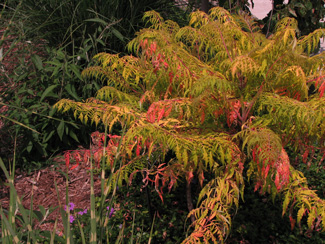Resource Library
Plant of the Week: Sumac, Tiger Eyes Golden
Tiger Eyes staghorn sumac is a stunning plant because of its bright golden foliage. (Image courtesy Gerald Klingaman)
Download High Resolution
Tiger Eyes Golden Sumac
Latin: Rhus typhina
It is fall and leaves are beginning to change. Sumacs, of which Arkansas has five species, have a prominent place in our lexicon of fall color. But one, the Tiger Eyes(™) sumac (Rhus typhina ‘Bailtiger’ PP 16,185) begins its color display in the spring when it first leafs out and continues the display into fall when the leaves change.
Rhus typhina, the staghorn sumac, is not native to Arkansas but instead is a species primarily relegated to the northeastern states with pockets of distribution as far south as Georgia and Tennessee and as far west as Minnesota. The species itself is a 15-to 25-foot-tall sumac with dogwood like proportions that spreads horizontally as all sumacs do, creating colonies that are capable of spreading twice its height. Staghorn sumac is so named because new shoots are covered with a reddish-brown downy pubescence similar to that seen on the antlers of deer when new horns grow in the fall.
Tiger Eyes sumac is different from the typical staghorn sumac in several ways. First, it is a low growing selection growing only six feet tall and wide. It still suckers but the plants I have been watching for the past five years confine the suckers close to the base of the original plant and it will take the colony considerable time to spread out of its original planting zone.
The second and most noteworthy characteristic of Tiger Eyes sumac is its dissected, bright yellow foliage. The pinnately compound leaves are to 18 inches long with each 3-to 4-inch-long leaflet incised into a number of slender segments. The foliage starts off in the spring as chartreuse green and then changes to bright lemon yellow during the summer and in the fall takes on tinges of orange. Unlike many yellow-leaved plants, this species neither burns nor fades to green during the heat of an Arkansas summer. The plant is a female clone so eventually will produce the erect, maroon spike of berries typical of sumacs.
Tiger Eyes sumac was first selected in July of 1985 in a Minnesota nursery by Steven Jorgensen, a then new employee of Bailey Nursery Company. Tiger Eyes showed up as a mutation (sport) off of a row of ‘Dissecta’, the old green, cut-leafed selection of staghorn sumac that was originally selected by a Massachusetts nurseryman in the late 1800’s. The sport turned out to be a stable chimera that, though slower to reproduce than the original parent, was stable.
The plant patent for the new plant, filed in 2004 and granted in 2006, was given the cultivar name of ‘Bailtiger’ with a trademarked name of Tiger Eyes™. Thus, according to the laws of commerce, it is illegal to propagate the plant until 2026 unless a specific agreement is reached with the patent owner. However, because all the promotion for the plant is done under the trademarked name which can remain in force forever as long as the paperwork is kept in order, the use of Tiger Eyes will remain off limits forever unless an agreement is reached with the originator of the patent.
Tiger Eyes is a showy and graceful addition to the border or it can be used as a specimen shrub near the patio or front entryway. Most of its foliage is concentrated at the ends of the branches so it provides an effective display in the summer months but the wintertime look is a bit bleak and barren. It is best suited to full sun locations in good, but not wet soils. Plants are hardy from zones 4 through 8. Once established it has good drought tolerance but attention must be paid during the establishment years or the young plants may die back to the ground.
By: Gerald Klingaman, retired
Retired Extension Horticulturist - Ornamentals
Extension News - September 27, 2013
